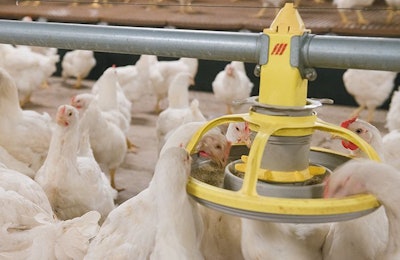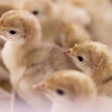
Feeding broiler breeders different diets in the morning and afternoon may benefit bird performance and farm economics, by supporting different physiological activities in the bird based on the time of day.
The split-feeding program is based on research conducted at Trouw Nutrition’s Poultry Research Centre in Spain, showing birds’ intake of protein and energy is higher in the morning, when the egg yolk is produced, while intake of calcium necessary to support eggshell quality increases later in the day.
The morning diet feeds protein and phosphorous to support production and laying, while the afternoon diet supplies nutrients that contribute to eggshell formation. In addition, the program tailors the levels of crude protein, apparent metabolizable energy, calcium and digestible phosphorous to morning and afternoon processes occurring in the bird.
Raising performance, improving economics
Originally introduced for laying hens, ForFarmers launched the split-feeding program for broiler breeders in April 2020, having previously evaluated it in laying hens with positive results.
ForFarmers’ Marketing and Technical Director Joost Sparla explains: “We were interested in how the good results we saw with laying hens could be applied to broiler breeders.”
The company approached split feeding for broiler breeders with two goals in mind. Firstly, lowering the feed cost for the farmer and, second, delivering a diet that supported better performance.
Egg laying economics
From an economics perspective, ForFarmers found that the cost of split-feeding could be slightly lower than a regular broiler breeder diet. He says that the economic benefit is achieved because the morning and afternoon diet is precisely adapted to the specific requirements of the broiler breeder in each daypart. By combining the precise nutrients to complement the processes occurring in the bird at different times of day, nutrients are available and metabolized when they are needed.
Assessing the reduction in feed cost is straight-forward. Sparla notes: “A direct economic benefit is the lower cost of feed. This can be calculated directly by the farmer, as he knows the regular feed price, and the price of the split feeding diet. In combination with the percentage of feed in the morning and afternoon, the cost price difference in feed is determined.”
Harmony and hatchability
While split-feeding requires two feeds as opposed to a single morning feeding, the transition was not a disruption at ForFarmers. Both farm workers and birds easily acclimated to the change in feeding programmes.
“The breeders adapted easily to the system of receiving feed twice a day. In fact, it resulted in less unrest in the house and a more harmonious view,” Sparla says.
“Perhaps the most remarkable finding was that supplying two meals a day for broiler breeders is possible.
“In the past, we thought that the amount of feed per meal would be too low, so only the strongest birds would have the possibility of eating enough. However, we see that feeding the birds twice a day results in less unrest and the uniformity of the flocks remains good.”
In addition to tracking a lower dietary cost, ForFarmers is gathering data on other metrics including total number of eggs and number of hatchable eggs. When possible, the company collects information on hatchability and chicken quality, but this data is more difficult to collect as the hatchery and broiler farm are not integrated with the breeder farm.
Sustainability and welfare
ForFarmers closely monitors its environmental footprint.
“When there are more hatching eggs produced with the same amount of feed, less raw material is needed to produce the same amount of day-old chicks. Therefore, the carbon footprint and land use will be improved as a lower amount of raw materials is needed,” Sparla explains.
Research conducted by Trouw Nutrition suggests that split-feeding programs allow broiler breeder hens to consume fewer nutrients, reducing emissions by up to 10% and thus reducing excretion of nutrients into the environment.
ForFarmers collaborated with Trouw Nutrition to train farm employees on the new feeding program and only make minimal operational changes were needed. The teams provide training to poultry farmers and advise on the investments needed to implement split feeding in broiler breeder operations. From an infrastructure perspective, the primary investment required is an additional silo. ForFarmers uses automated equipment to ensure that the feed automatically switches over from the morning to the afternoon diet.

A second silo will need be installed to separate the diets. | ForFarmers
Integrator experience
Headquartered in Spain, Grupo SADA is a Nutreco company specializing in integrated poultry production. The company’s fresh and processed chicken meat operations cover all segments of the production chain from breeders through incubators, fattening farms, processing and distribution.
Grupo SADA piloted the split feeding concept in 2015. Pilot efforts focused on opportunities to improve hen welfare, fertility and eggshell quality, while reducing chick production costs. From an operational perspective, the team assessed and evaluated feed distribution, ensuring the proper amount of feed to distribute during the morning and afternoon feeding.
Similar to ForFarmers’ experience, Grupo SADA recognized a decrease in the dietary cost when switching from a morning only diet to a specific morning and afternoon diet. Farm workers also noted behavioral changes indicative of a more relaxed flock.
Alberto Navarro, Broiler Production Manager, notes: “We saw the hens receiving the split-feeding diet were less stressed than birds getting the regular diets, and we saw a reduction in feed cost”.
He cites an observable reduction in pecking activity and, while somewhat subjective, the team observed improved feathering which could be related to more relaxed hens.
An improvement of particular interest was the confirmation of better eggshell quality resulting from a higher thickness in the eggshell. Quality criteria for evaluating eggshell parameters include weight, thickness, breaking strength and shell weight per unit of egg surface area (SWUSA) values.
Considerations for split-feeding
The primary investment when implementing split-feeding is the addition of a second silo to store two different diets. The cost of this investment is typically recouped in less than a year. As workers on broiler breeder farms tend to have high management skills and knowledge, the training process is very efficient. Farm advisers work with each farmer to tailor the split-feeding system.
Timing isn’t everything when it comes to poultry production - improving bird performance and farm profitability is a multifactorial process. However, as the experiences at ForFarmers and Grupo SADA show, tailoring nutrition to the time of day can support bird performance, farm profitability, animal welfare and sustainability efforts.

















